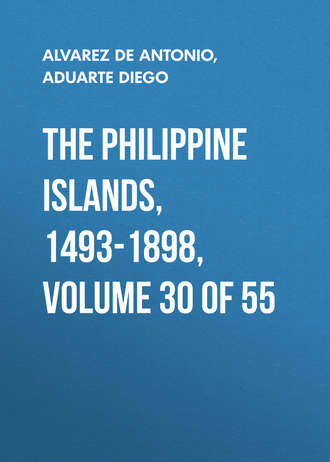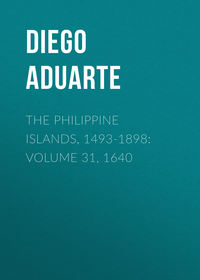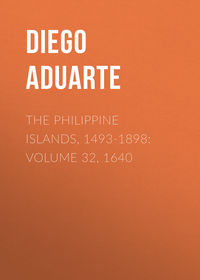 полная версия
полная версияThe Philippine Islands, 1493-1898, Volume 30 of 55
22
Juan Ormaza de Santo Tomás was born at Medina del Campo, in September, 1548. His studies were pursued at Salamanca; after graduation he spent several years in teaching and was engaged in this occupation at Valladolid when Crisóstomo went thither to secure missionaries for Filipinas. Ormaza enlisted in this new field, and, after arriving at Manila, he was assigned to the district of Bataan. Here he “reduced to two villages, with some visitas annexed, the thirty-one hamlets among which the Indians were dispersed; made bridges over the rivers; hindered with palisades (which those people call tabones) the inroads of the sea, which had ruined their grain-fields; and adorned the churches with altars, sacred images, and paintings.” During 1610–14 he was engaged in the missions of Japan; the rest of his life, except 1619–21 and 1623–25, when he ministered to the Chinese in the Parián and in Binondoc respectively, was spent at the Manila convent – where he died on September 7, 1638. (Reseña biográfica, i, pp. 86–91.)
Pedro de Soto was a native of Burgos, and pursued his priestly studies at Valladolid; soon after his graduation he joined the Filipinas mission. His first charge was in Pangasinan, where he labored zealously, amid great opposition and hostility from the natives. A serious illness at last compelled him to return (1599) to Manila, where he died.
23
Juan Cobo, a native of Castilla, joined the Dominican order at Ocaña, and was a student at Avila and Alcalá de Henares. He came to Nueva España with the mission of 1587; during his stay there (prolonged another year, on account of certain business of the order) he rebuked the viceroy of Mexico so boldly that the latter ordered Cobo to be exiled to the Philippines. Arriving at the islands in May, 1588, he began his labors among the Chinese of the Manila Parián, and later went among those of Tondo. In 1592, Cobo was sent by Dasmariñas as ambassador to Japan; having fulfilled his commission he set out on the return to Manila, and is supposed to have perished by shipwreck, as nothing more was ever known of him or his ship.
24
“Peña de Francia is a lofty mountain in the province and diocese of Salamanca, twelve leguas from this city and seven from Ciudad-Rodrigo. On its rugged summit is the celebrated convent-sanctuary of this name, where the community resided from Easter until November 2, at which time they went down to another house, on the slope of the same mountain, only two or three brethren remaining above for the care of the sanctuary.” (Reseña biográfica, i, p. 95, note 1.)
25
Pedro Bolaños was master of novices in the convent of Peña de Francia when he decided to enter the Filipinas mission, and was then sixty years of age. He labored among the natives of Bataan for a little while; but the responsibilities of this work, the hardships of missionary life, and his advanced years, were too much for him, and he died before he had spent a year in Filipinas. (Reseña biográfica, i, pp. 95–97.)
26
Juan de la Cruz, labored first among the natives of Pangasinan, and was afterward sent among those of Bataan, where he became very proficient in the Tagál language. He was provisor of the archdiocese under Benavides, until the latter’s death; then he returned to Bataan, where he died, probably near the end of 1605. (Reseña biográfica, i, pp. 100, 101.)
27
Apparently meaning the Jesuit Alonso Sanchéz, who was then in Nueva España, on his way to Spain.
28
At that time, the marqués de Villamanrique (VOL. VI, p. 282).
29
The younger Juan de Castro was a priest in the Dominican convent at Barcelona when the Filipinas mission enterprise was begun. Arrived in the islands, he was sent to Pangasinan; and, at the end of 1593, accompanied Fray Luis Gandullo on an embassy to China. On their return, they were shipwrecked off the coast of Pangasinan; and the exposure and suffering incident to this misfortune brought on a serious illness, from which Castro died early in 1594.
Pedro de Soto was a native of Burgos, and pursued his priestly studies at Valladolid; soon after his graduation he joined the Filipinas mission. His first charge was in Pangasinan, where he labored zealously, amid great opposition and hostility from the natives. A serious illness at last compelled him to return (1599) to Manila, where he died.
30
Religious life (religion): Religion, as used by Aduarte, means solely the rule of life followed by a religious order, the order itself, or the ideal of the order; and derivative words have corresponding significations. For instance: “at the expense of the order (la religion),” book ii, p. 77; “to the no small credit of our religious community (nuestra religion), with the members of which (cuyos religiosos) they generally have most to do,” book ii, p. 83; “the act which he was performing because of his duty as a religious (acto religioso),” book ii, p. 104; “sufficient to give glory to an entire religious order (una religion entera);” “all the religious orders (las religiones) in the Indias.” As an adjective, a “very religious” friar (religiosissimo padre, book ii, p. 376) means one who remarkably approaches the ideal of the order. In this sense religioso has generally been rendered by “devoted” in this translation. The noun “religious,” in the sense of “a member of an order,” and the adjective in such phrases as “a religious house,” “the religious life,” are still not rare in English. – Henry B. Lathrop.
31
The full text of these ordinances may be found in Reseña biográfica, i, pp. 18–30; it is in Latin, accompanied by a Spanish translation, which differs considerably from Aduarte’s, following the Latin more closely than his. The devotion to the Virgin Mary which is here mentioned (also known as the coronilla, or “little crown”) is given ut supra, p. 29. The initial letters of the first words in the psalms selected for this purpose form the name “Maria,” as do those of the corresponding antiphons – thus producing a double acrostic on her name. Gregory XIII granted an indulgence of one hundred days for those reciting this devotion.
32
The present province of Bataán is on the western shore of Manila Bay, being the peninsula formed between that bay and the sea. But the description in the text, together with other mention of Bataán (or Batán) in old documents, makes it evident that the name was applied in Aduarte’s time to at least the western part of the delta at the mouth of the Rio Grande de Pampanga, in the southwest part of the present Pampanga province.
33
Salaries were paid from the royal treasury in installments thrice a year, hence in thirds (tercios).
34
So in the text, but evidently referring to the beginning only of constructing the new church.
35
i. e., “Take heed to thyself and to doctrine;” and, “in doing this thou shalt both save thyself and them that hear thee” – both quoted from 1 Timothy, iv, v. 16.
36
Dias que no son dobles: in church terminology, feast days whereof the canonical offices are observed according to double rite – or duplex feasts, as sometimes styled in English liturgical works. In church calendars, the rite to be followed every day of the year is determined (according to fixed rules) with a view to its greater or less solemnity. The various designations thus employed are: simple, or simplex; semi-double, or semi-duplex; double, or duplex, and these may be minor or major; major double of the second class; and major double of the first class. Of this last sort are the most solemn feasts, as Christmas, Easter, Pentecost; while a feast day of simple rite is of the lowest class. – Rev. T. C. Middleton, O.S.A.
Cf. Addis and Arnold’s Catholic Dictionary, art. “Feasts” and “Feria,” where full details, and the origin and application of the terms, are given.
37
Juan de Santo Domingo assumed the Dominican habit in the convent at Salamanca, and later came to the Philippines. He spent two years (1610–12) in the missions of Bataán and Pangasinan, and six years in Manila and Binondo; and in 1618 undertook, but unsuccessfully, to start a mission in Korea. He then remained a little while in Japan, where he was arrested (December 13, 1618) and imprisoned. Condemned to suffer death by torture, he was carried away by a sickness instead (March 19, 1619). He was beatified on July 7, 1867. (Reseña biográfica, i, pp. 207, 208.)
38
Little is known of Alonso Montero, save that he belonged to the province of Mexico, where he spent several years, and afterward labored two years in the Pangasinan mission. His name does not appear in the records after 1592. (Reseña biográfica, p. 146.)
39
Juan García was for some time a minister to the Indians in Nueva España; he came to the islands in 1588, and labored in the missions of Bataán and Pangasinan. He died about 1603. (Reseña biográfica, i, p. 138.)
40
Tomas Castellar, from the Dominican convent at Barcelona, went to Mexico, where he filled various high positions in his order. He came to Manila in 1589, where he remained three years; in 1592 he was sent to Pangasinan, and, two years later, aided in founding the Cagayan mission. Returning to his former field, he labored with those natives until his death (1607).
Pedro Martinez came to the islands in 1588, and was placed in various posts in the Manila convent, for which he proved to be unfit from his habit of being absorbed in contemplation. He was then sent to Pangasinan, where he died (1592) from the effects of the climate.
Juan Bautista Deza remained some time in Pangasinan; then, as he had some knowledge of surgery, accompanied an expedition to Camboja. Nothing is known of him after 1600.
(See Reseña biográfica, i, pp. 138, 145.)
41
Spanish, apostola de los apostoles. One of the word-plays of which the old religious writers were so fond. No literal translation conveys the meaning here implied; but apostola is used (as also in English) with the primitive meaning of “apostle,” as one who first introduces the gospel – in this particular instance, one who first announces the good tidings, i. e., of Christ’s resurrection.
42
Spanish, lector, literally, “reader;” applied to one who gave lectures in theology, especially moral theology.
43
Amaranthus; see Delgado’s Hist. Filipinas, pp. 724, 725; and Blanco’s Flora, p. 491. Cf. VOL. XV, p. 111.
44
Probably referring to the feast of the Assumption of the Virgin, which fell on August 15.
45
See portrait of Dasmariñas here presented; it is a photographic facsimile of an old painting (possibly a later copy of an authentic original) which was displayed in the Manila house in the Philippine exhibit at the Louisiana Purchase Exposition (St. Louis, 1904). The inscription on the scroll held by the page reads thus, in English: “Don Luis Perez Dasmariñas, knight of the Order of Alcántara, governor and captain-general of these Filipinas Islands for the king our lord, and founder and owner of this village of Binondo. He obtained this land by purchase, March 28, 1594, from Don Antonio Velada, husband of Doña Sebastiana del Valle, for the sum of $200. This sale was authorized by the certificate of Gabriel Quintanilla, a notary-public, one of the number allotted to this very illustrious and loyal city; and the grant of feudal rights over the Sangleys and mestizos of this said village, on May 29, 1594.”
46
See account of the first printing in the islands (1593), in vol. ix, p. 68; and that of printing in China, in vol. iii, p. 206.
47
Tomás Mayor came to Manila with the Dominican mission of 1602, and spent several years in their residence of San Gabriel among the Chinese; he composed a useful catechism in that language. In 1612 he went to Macao, at the summons of the bishop there; but finding it impossible then to found a Dominican house at Macao, he departed thence for Europe – dying, however, in that same year, before reaching his destination.
48
Francisco de la Mina, an Andalusian, was a missionary among the Mexican Indians during forty years. Coming to Manila in 1589, he labored in Bataán for a time; and was afterward made prior of the Dominican convent in Manila, where he died in 1592.
49
A topic then of special interest to the Dominicans, since Bishop Salazar (who belonged to their order) had but recently been involved in a hot controversy with Dasmariñas over the collection of tributes from the Indians (see correspondence between them at end of VOL. VII and beginning of VOL. VIII). All the missionaries in the islands had opposed slavery, whether among the Indians or the Spaniards; and the latter had adopted this practice to such an extent that Gregory XIV commanded them in 1591 to cease it entirely (VOL. VIII, pp 70–72).
50
A cape (now known as Piedra Point) at northwest extremity of Zambales peninsula, Luzón; name also applied to the narrow channel between that cape and Purra Island.
51
Cf. with this the description in Sir Thomas Malory’s Morte d’Arthur (book xxi, chap. iv) of the last and fatal combat between King Arthur and Sir Mordred: “And when Sir Mordred felt that he had his death-wound, he thrust himself unto the bur of King Arthur’s spear,” and with this final effort dealt a mortal blow on the king’s head.
52
Spanish, viva quien vence; equivalent to the English saying, “Might makes right.”
53
Spanish, pascuas. Certain great church festivals last three days or more in Spain.
54
All these are towns on or near the northern coast of Cagayán.
55
Miguel Martin de San Jacinto made his profession at Salamanca, in 1586. He seems to have spent his life after coming to the islands (1595) in the Cagayán missions, in which he was a prominent worker. He died there, at Abulug, April 26, 1625.
Gaspar Zarfate was a native of Mexico. He spent some time in Cagayán, and afterward in Manila, where he filled various important offices in his order. He died at Manila, March 9, 1621; and was the first who systematized the grammar of the Ibanag dialect.
Ambrosio Martinez de la Madre de Dios, a native of Guatemala, made his profession at Mexico in 1589. Reaching the Philippines in 1595, he spent the rest of his days in the Cagayán missions, where he died in April, 1626.
Domingo de San Blás came to the islands from the Dominican convent at Sevilla, and spent several years in the Cagayán missions; he died at Manila, in 1601.
Antonio de Soria came from the convent at Puebla de los Angeles, Mexico. He labored so earnestly in the Cagayán missions that he soon wore out his strength; and died at Lal-ló about the beginning of 1599.See Reseña biográfica, i, pp. 181–184.
56
The instructions given in this matter to the Spanish officials and missionaries, and the manner in which they carried out these, may be found in VOL. X, pp. 277–288.





